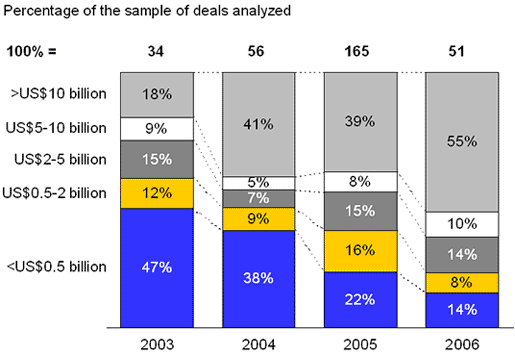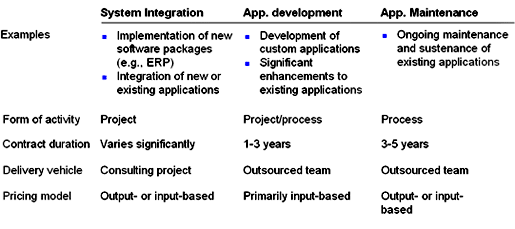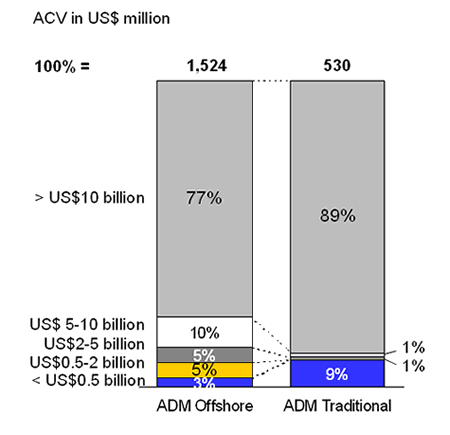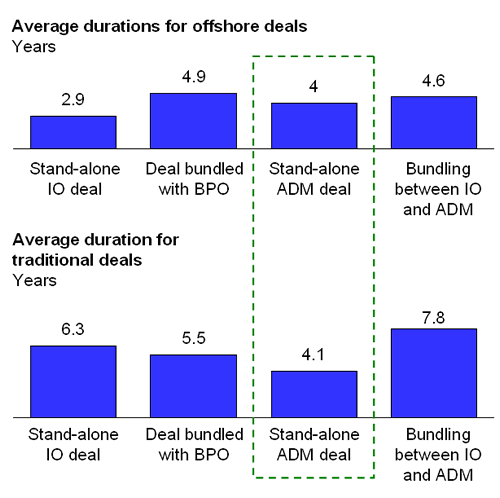

To better understand key market trends and how they affect the mature IT outsourcing market, Everest conducted an ITO study during the third quarter of 2007. Here are the major trends:
Key findings – infrastructure outsourcing (IO)
We segmented IO into two operational models: Traditional IO and remote infrastructure management outsourcing (RIMO). These models differ substantially in terms of maturity of the offering and buyer adoption trends. Exhibit 1 shows the key differences between the models.
Exhibit 1. Models of infrastructure outsourcing
Traditional IO | RIMO | |
Scope of contract | Data center outsourcing | Remote Server Management |
Scope of contract | Complete service | Task or fractions of the function |
Pricing | Output | Mostly input |
Size of | Large | Small |
Length of contract | Long (5-7 years) | Short (3-5 years) |
Asset | Very frequent | Very rare |
People | Very frequent | Very rare |
Traditional IO suppliers showed relatively mature offerings. They focused primarily on large buyers (more than $10 billion in revenue), driving almost 80 percent of annualized contract value (ACV). Buyers also tend to sign longer-term, highly-bundled contracts with suppliers of traditional IO services: 69 percent of deals were multi-tower contracts (combinations of data center, network, desktop, and helpdesk outsourcing).
However, the RIMO model is evolving rapidly and is showing signs of convergence with the traditional IO, as is evident from changes in pricing and buyer adoption. While medium-sized buyers (< US $5 billion in revenue) drive more than a third of RIMO deals, RIMO suppliers are steadily moving from serving small and medium businesses (SMBs) into the “big league,” focusing on larger buyers enterprises (see Exhibit 2 for the RIMO trend). In addition, about 60 percent of RIMO deals are bundled, multi-tower contracts, reflecting increasing buyer confidence in RIMO suppliers.
Exhibit 2. Deal distribution by buyer’s annual revenue for RIMO suppliers

RIMO deals have predominantly utilized input-based pricing mechanisms, reflecting the rather basic value proposition of labor arbitrage. However, RIMO suppliers are now beginning to adopt output-based and combination pricing models in addition to input-based pricing, which is most likely a result of inclusion of transformational IO services into the RIMO work mix. This can also be traced to the capability-building efforts of large RIMO suppliers, many of whom have acquired specialized IO firms based in client geographies (e.g. Cognizant acquired Aimnet, Wipro acquired Infocrossing, etc.)
Buyers’ preferences in sourcing infrastructure also vary across traditional IO and RIMO suppliers. Public sector buyers play a disproportionately higher role in traditional IO, accounting for 44 percent of the market by ACV. This is most likely because offshore delivery is the predominant driver of the RIMO model, and this does not enjoy a high adoption in the public sector. RIMO has also witnessed slower adoption in the Asia Pacific (APAC) region, where buyers appear to be hesitant to commit to large deals with RIMO suppliers.
Key findings – ADM outsourcing
ADM outsourcing also consists of several business models. We divided ADM outsourcing into three segments: application development, application maintenance, and system integration. Two distinctly different types of suppliers serve each segment: traditional on-site suppliers and offshore suppliers. Exhibit 3 shows key characteristics of the ADM business models.
Exhibit 3. Models of ADM outsourcing

ADM outsourcing is entering a more mature phase, which is apparent in the similarity of characteristics exhibited by traditional and offshore suppliers across key market metrics.
Exhibit 4. Deal distribution by buyer’s annual revenue for ADM suppliers

Despite the similarities, there are subtle differences between the two supplier categories. While ADM activity of offshore suppliers is centered mainly on labor arbitrage, traditional suppliers are becoming more creative around delivery and pricing (risk-reward, gain-sharing, etc.), leading to higher instances of combination pricing in traditional suppliers’ deals. Also, the fact that offshore suppliers have significantly smaller deals with large buyers suggests that they are still operating in a ‘penetrate and radiate’ mode for large buyer accounts.
The ADM market exhibits fairly interesting bundling trends. Only 27 percent of ADM deals are stand-alone, single-tower deals. Two towers are the most frequent form of ADM deal bundling, and buyers choose to outsource AD and AM together in one bundle in preference to other combinations. Buyers also typically bundle system integration (SI) with associated AD/AM activity. However, buyers frequently source application maintenance independently of other ADM activities.
Almost 30 percent of ADM deals are leveraging multiple offshore geographies for delivery, reflecting increasing adoption of the global delivery model and suppliers’ ability to handle the additional complexity imposed by multi-region delivery.
When looking at deals with single-region offshore delivery, however, India is the overwhelming choice of location. Also, India was present in 85 percent of all the deals that involve offshore delivery. Other regions like South America and Eastern Europe serve as near-shore centers for the North America and Europe geographies, but they still have some way to go in terms of location maturity.
Key Findings – Bundling trends across ITO and BPO
One of the areas of inquiry was to understand bundling trends within ITO and between ITO and BPO. We found that the bundling of BPO and ITO deals is an infrequent occurrence and usually results in smaller deals that account for less than 10 percent of the total signings in the sample.
The second interesting trend is that while stand-alone IO and ADM deals occur much more frequently, both offshore and traditional suppliers derive the largest share of their signings from contracts that are a bundle of IO and ADM.
Thirdly, the functional scope of the contract often dictates choice of pricing models, e.g., the presence of IO in the scope of the deal drives the share of output-based/combination pricing across traditional and offshore suppliers.
Exhibit 5 shows that traditional suppliers exhibit higher deal durations across most scope combinations except for stand-alone ADM, where there is no significant difference in deal durations between traditional and offshore suppliers.
Exhibit 5: Average deal duration across ITO offerings

How the study was done: Everest conducted an ITO Request for Information (RFI) exercise in Q3 2007. The company analyzed representative sample of responses from 12 ITO suppliers with headquarters in Europe, North America, and India. This RFI studied outsourcing transactions that fall into either IO or ADM outsourcing or consist of bundles of IO and ADM offerings within a single contract.
To focus the inquiry on the high-value IT outsourcing market, Everest asked respondents to report their 25 largest ITO deals by total contract value. Everest analyzed a total of 437 deals. The data assembled explains the behavior of the large enterprises segment of the ITO market and is not directly applicable to smaller buyers with annual revenue less than US $1 billion.

